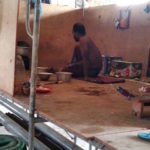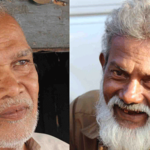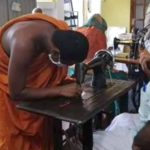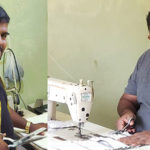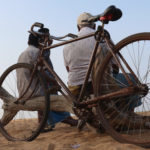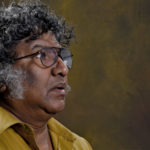Just one shirt for the whole year
Free uniforms?
“If not for the free uniform provided by the state, it’s a fact that many children would be deprived of an education,”
‘What is it, Kamalam akkaa?
‘Oh …. The white shirt is not dry … that’s all’
We hear several conversations of this nature from the people of the village.
“Sometimes children go to school with clothes that are still wet. The children of our village are able to go to school because of the free uniform and books provided to them. If not, they will not be able to get an education. They cannot afford to buy an extra uniform and are dependent on the single uniform issued by the government. If the school term runs for 180 days, students would wear the same uniform for the entire period. I think the students here are those that use the government’s uniform for the longest time” says Vannamani Sivappirakasam of Paduvan Karai, referring to students in the Paduvankarai area in the Batticaloa district.
There may be several reasons why children are absent from school. But there are children who do not go to school because there is no shirt to wear. Soaked clothing does not dry easily during the rainy season. Some people go to school with clothes that are not dry yet and come back with dirty uniforms because of dusty streets and the dirt collected on old school furniture, many parents complained.
Many people living in urban areas don’t even know why the government offers money for uniforms. Some say ‘we can’t buy even a good shirt with that money. We need 5 shirts to put on every day.’ They don’t care about free uniform voucher. All too often, children from urban areas come to school in a vehicle. It is rare that their uniforms get stained. But the situation is not the same for rural children.
“The distance between home and school is longer, students have to walk through ditches and pitfalls. They walk through narrow footpaths full of thorny bushes. And the likelihood of their uniforms getting torn or stained is higher during school sports periods. Children can only go to school only after getting their torn uniform stitched and patched” says 72-year-old resident of the village, Muthulingam Navarathinam.
His grandchildren are also studying at a school in Paduvankarai. As a grandfather, it is his duty to take the children to school in the morning and bring them back home.
“My brother, how many clothes we will change per month. Do we wear the same dress every day? Not at all. But the children who attend school wear the same dress every day. Sometimes the child’s garment gets stained from fruits they eat and these stains aren’t easily removable when washed. But the child has to wear the same uniform for an entire school year with the hope of getting a new one the next year. We are daily wage earners. What can we do?” He asks with concern.
Paduvankarai is an agricultural village. Men work outdoors in sun and rain without a top garment. Women work the fields in faded dresses they wear to cover their bodies while they work. In this situation the free uniform for students is a bounty. But after sometime, that uniform gets faded and the white color changes to a light yellow. Children in this area rely solely on school education. If they have special classes after school, they cannot go to school the next day.
“If there are any afternoon classes or programs at the school, it would be dusk when they reach home. Then they get exhausted and are unable to wash their school uniforms the same night. This makes them unable to go to school the next day. If it is rainy season, the children’s attendance is very low,” Ilaiyathambi Kuganathan, the teacher of one of the schools says.
Over 50 percent of children have just one shirt. Whether to go to school or not depends on that shirt. Students are not allowed even for a day to wear colored clothes as a substitute for a uniform.
“There have been times that I could not go to school on a day when an important lesson is taught since I have only one uniform, I felt ashamed to tell others So, teachers reprimand me for not attending school” says a 14 year old female student.
Previously, the government provided the fabric for a uniform. But since 2016, a ‘voucher’ is given to students to purchase material. So families still need to pay for tailoring. Charges for a girl’s uniform is Rs. 200 and a boy’s uniform is Rs. 400 (shirt and trousers). Often families have as many as 4 children. Due to the lack of affordability, children go to school with one uniform.
The situation in Paduvankarai is similar to many agricultural villages in Sri Lanka. If not for the free uniform provided by the state, it’s a fact that many children would be deprived of an education.

